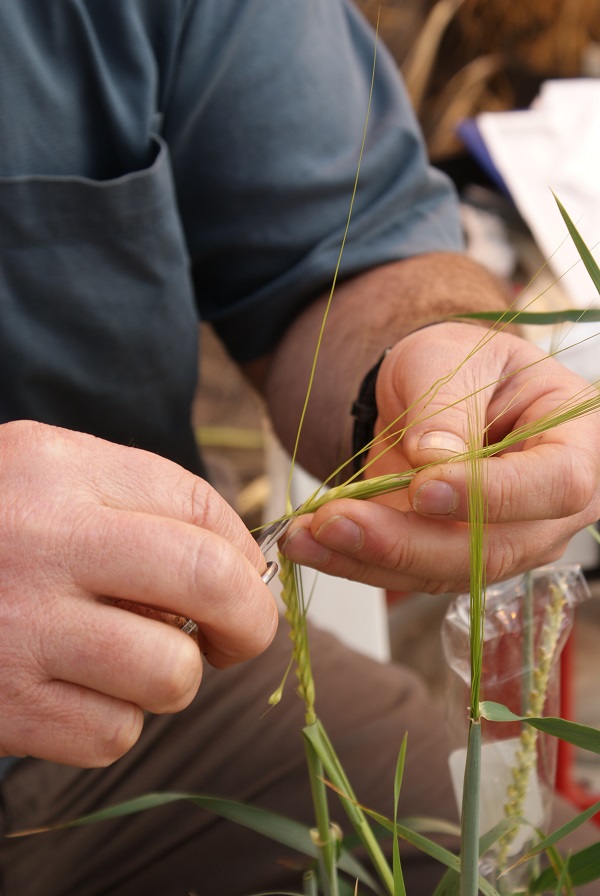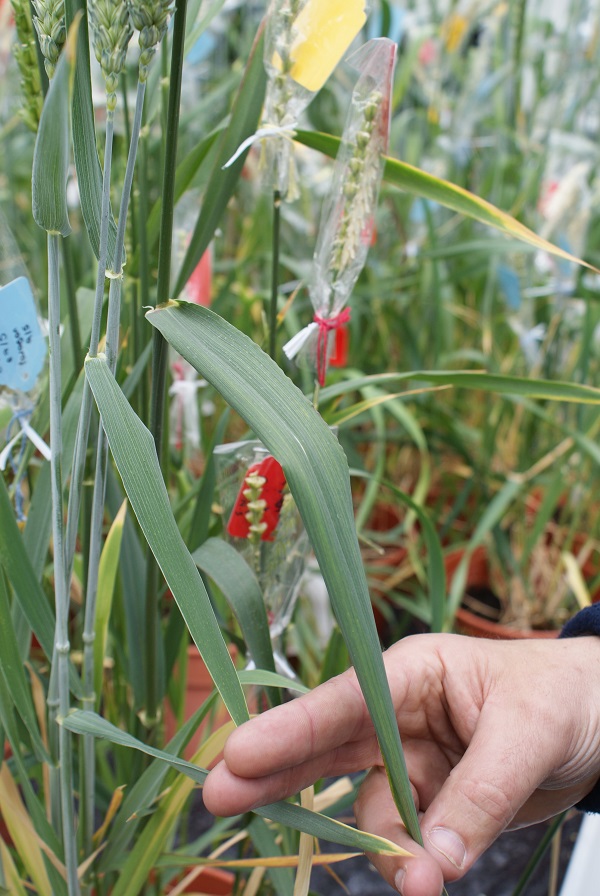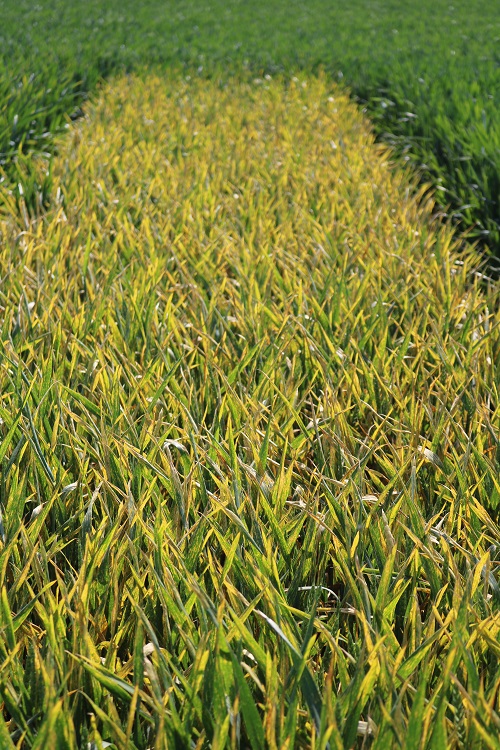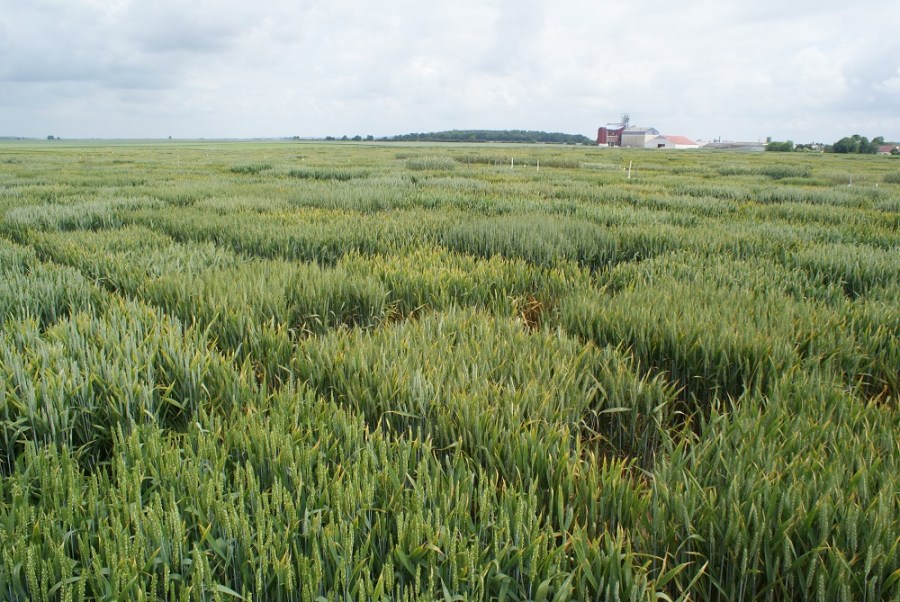Huge improvements have been made by plant breeders in the disease resistance of cereal varieties. But has fungicide chemistry helped its progress or stifled innovation? CPM assesses recent developments.
It’s unrealistic to suppose that present levels of food production can be maintained just by growing varieties with the best disease resistance currently available.
By Tom Allen-Stevens
Progress for a plant breeder may be a little like keeping up with the Red Queen in Through the Looking-Glass. No matter how fast the advances, all you’re doing is racing to stay in the same place. Despite continual improvements in the disease resistance of commercial wheat varieties, the key pathogens evolve and grow ever stronger.
“At the moment, it’s unrealistic to suppose that present levels of food production can be maintained just by growing varieties with the best disease resistance currently available,” argues Prof James Brown, project leader in crop genetics at the John Innes Centre.

Breeders have discovered that introducing mutations of mlo result in broad-spectrum resistance to mildew.
“Significant progress in disease resistance has been achieved by breeders, but this takes time to develop. One of the main uses of systemic fungicides is to allow growers to achieve the genetic potential of a wheat variety, and control new and evolving pathogens, while the breeders are building in the defences that plants need to protect themselves.”
Balance in the field
It’s a balance that’s been played out in the field since fungicides were first introduced over 50 years ago, he says. “Previously, growers would either put up with a certain level of disease or grow crops that weren’t susceptible. Fungicides took the pressure off and allowed farmers to grow the food that consumers wanted at the level of production supply they demanded.”
But the pressure may now be coming back on, he fears. “If current regulations cause the number of fungicides or opportunities to use them to be greatly reduced, farmers won’t be able to respond to new diseases. What’s more, it’ll become much harder to control existing diseases effectively and combat unexpected outbreaks of disease on normally resistant varieties.”
There are a number of genetic factors that play into the mix and make breeding for disease resistance a very complex business, he explains. “When it comes to resolving a problem such as septoria resistance, there’s the trade-off with yield, and breeders have to take that into account.”
Recent research, supported jointly by industry and Defra through the Sustainable Arable LINK programme and carried out at JIC, traces this problem back to decisions made nearly 60 years ago. “What we found was that it related to wheat crosses made before septoria was ever even identified as a serious threat to wheat production,” says James Brown.

The gene with the biggest effect on increasing susceptibility to septoria is very closely linked to one that increases yield and grain size.
He and a colleague Dr Lia Arraiano analysed resistance and susceptibility to septoria in wheat varieties grown in the UK between 1860 and 2000. Using a technique called association genetics, they found that the gene with the biggest effect on increasing susceptibility to septoria is very closely linked to one that increases yield and grain size.
“We discovered a small region of the genome that governs increases both in septoria resistance and yield. We traced it back to a variety called Heines Peko, which was used to breed for yield and rust resistance in the late 1950s.”
Heines Peko was crossed with Cappelle Desprez, the major wheat variety in Britain at the time. This cross was so influential that all modern wheats bred in Britain are descended from it. “As wheat breeders selected ever more strongly for higher yield, susceptibility to septoria hitch-hiked along with it.”
Work is now underway to discover if the connection between the two traits can be broken. The research team has found ten other genes scattered throughout the genome with smaller effects on septoria. They also found that nearly half the variation in septoria was controlled by genes with effects that were too small to identify individually. “We know the genes are there, but we don’t know where they are,” says James Brown.
Durable advances
Focusing in on these genes will help commercial breeders make durable advances in septoria resistance without compromising yield, he believes, although significant progress has already been made. “For the past 10 years, no variety with a septoria rating lower than 5 has been added to the AHDB Cereals and Oilseeds Recommended List for winter wheat. There are now five varieties that combine septoria-resistance ratings of 7 with high yields,” he notes.
There are other areas, however, where breeding achievements have resulted in undesirable trade-offs. “A major success in plant breeding for disease resistance is the broad-spectrum, durable control of powdery mildew in barley conferred by recessive alleles of mlo,” notes James Brown.

There’s a real question mark over yellow rust now and it’s a considerable challenge for breeders.
Mlo is a gene in barley that causes a protein to interact with a plant in such a way that its natural defence is down-regulated. This makes the plant more susceptible to powdery mildew. So breeders have discovered that introducing mutations of mlo result in broad-spectrum resistance.
The mlo-11 allele is most commonly used and is currently present in around half the spring barley cultivars grown across Europe. Introduced from an Ethiopian landrace in the 1970s, this mutation results in very low levels of the MLO protein, which in turn confers very strong broad-spectrum resistance to mildew.
“It’s been remarkably successful to the point that mildew is no longer considered a serious threat for spring barley growers,” says James Brown.
“But there’s a drawback. An undesirable side effect has been the rise of the leaf-spotting disease ramularia. Caused by the fungus Ramularia collo-cygni, this became a significant disease in 1998, but was little known before that. We now know that mlo makes barley more susceptible to ramularia although we don’t know if that’s what drove the rise of ramularia.”
This was confirmed in a study carried out at JIC and the James Hutton Institute and completed in 2014. Two doubled-haploid populations of spring barley were studied in field trials and in polytunnels. These showed the presence of mlo alleles increased the severity of ramularia, in both seedlings and adult plants.
In other laboratory experiments, mlo alleles have been associated with susceptibility to other diseases, including fusarium head blight and net blotch. “Although mlo mutations bring the benefit of mildew resistance in barley, there are alternative methods of control, such as systemic fungicides and breeding for partial resistance. Farmers have used fungicides to control ramularia and other diseases of barley. So even though mildew has been well controlled, farmers have not necessarily saved much money.”
However, another observation of the mlo study was a large variation in susceptibility to ramularia across the populations in both the field and polytunnel trials. Further analysis of the genetics revealed other genes that conferred significantly less susceptibility to ramularia while keeping the benefit of mlo-11 to control mildew.
“The results here indicate that plant breeders should be able to combine mlo-11 mildew resistance and polygenic partial resistance to ramularia in spring barley cultivars. Indeed, that’s what we’ve seen over the past 15 years as ramularia has grown in prevalence. Fungicides were relied on entirely to control this new disease in its early days, but now there are a number of varieties on the RL with good resistance scores for ramularia,” he notes.
But has it been the RL and its focus on yield that has driven growers towards more disease-susceptible varieties and resulted in breeding for resistance becoming a lower priority? “I don’t think that’s a fair criticism of the process,” counters James Brown.
“There have always been minimum standards for disease resistance and agronomic traits. Only varieties that have reached those minimum scores have made it onto the RL.”
However, there has been a noticeable shift in recent years. “Clearly there’s now a demand for growers for less reliance on fungicides, which may be driven by increasing resistance, as well as regulatory issues. There’s also now a greater emphasis on disease ratings when selecting varieties for the RL – a high septoria score for example is given considerable weight in the overall evaluation.”
This has resulted in an RL with a good selection of robust varieties, he believes. “While 20 years ago, many varieties had good resistance to most diseases, they were susceptible to one or two others, so still needed a robust fungicide programme. Now, a rating of 5 or higher for all diseases is the norm. It’s a slow improvement, because breeding is a slow process. But over the last two decades, it’s been a dramatic improvement.”
But disease continues to bowl its curved ball, and even the most robust, broad-spectrum varietal resistance is vulnerable. “Yellow rust is a classic example of the Red Queen’s race that breeders are running,” points out James Brown.
Single gene resistance
“Brigadier was a variety with very good resistance when it came on the market, but this relied on a single gene. The pathogen soon overcame this and the variety quickly broke down. Breeders have become better at building in both single gene resistance as well as greater levels of multi-gene protection and such dramatic breakdowns were rare between 2000 and 2010.
“But there’s a real question mark over the pathogen now and it’s a considerable challenge for breeders. Since 2011, new races of yellow rust have arrived in Europe. They’re more aggressive that the old races and harder to control. We have to understand what’s happening at a genetic level and how to breed varieties with built-in protection. In the meantime, I hope the regulators have the sense to allow growers continued access to a well equipped fungicide armoury.”
Pre-breeding holds promise, but it’s the long game
Pre-breeding research could be broadening the pool of genetic material available to breeders to build more resilient disease resistance into varieties. According to Dr Phil Howell of NIAB, there’s no shortage of innovation nor determination to do so – it’s simply a question of the right funding and enough time.
“In some ways, pre-breeding research has been a victim of its own success,” he says. “We’re capturing more diversity, but for this to be useful in commercial breeding lines, more interrogation of the material must be carried out, and there’s no underpinning long-term funding for this work.”
One on-going project underway at NIAB is MAGIC, a Multi-parent Advanced Generation Inter-Cross plant-breeding programme. This has taken eight well known varieties – Alchemy, Brompton, Claire, Hereward, Rialto, Robigus, Soissons and Xi-19 – and crossed them, every which way, to produce 1400 new lines, each containing combinations of genes from all eight parents.
This crossing has taken place over multiple generations, explains Phil Howell. “One difference between what we’ve done and what would happen in commercial lines is that we’ve kept every cross, and taken it to yield. What we’re doing is shuffling and reshuffling the pack, and finding gene combinations that we haven’t seen before. The genes themselves aren’t novel, because they’ve come from parent material already in commercial lines, but there are some interesting new combinations.”
One outcome he’s confident is lying within these lines is a more durable yellow rust resistance, for example. “Single gene resistance is easy to track down these days with genetic markers. But the more durable multi-gene resistance relies on traditional breeder skills and selection to identify it and bring it to a stage where it can be introduced into commercial lines. We need time and resource to study the material to find out exactly what we have.”
Arguably a more novel programme is NIAB’s synthetic wheats. Researchers have returned to the original cross with wild goat grass which created hexaploid wheat some 10,000 years ago. “Modern varieties don’t contain many of the genes that have been bred out over the ages, that could now be valuable in addressing today’s breeding challenges. This programme gives breeders the opportunity to reintroduce that variation back into modern lines.”
Genome editing may hold further promise for pre-breeding research. One recent success has been achieved by a group at the Chinese Academy of Sciences Institute of Genetics and Developmental Biology in Beijing. Using TALENs (transcription activator-like effector nuclease) methodology, the scientists have managed to induce mlo mutations in wheat that confer durable resistance to powdery mildew.
While this was bred into barley in the 1970s, as wheat is a hexaploid, the mutation had to be created simultaneously across each of its three genomes, and then faithfully inherited. This makes it the first heritable mutation of its type in hexaploid wheat, and the first instance of successful simultaneous editing.
But the technology has its limitations, explains Phil Howell. “Genome editing can help you target what you’re looking for in a cross, but you have to know what you’re after in the first place. The difficulty with most traits is that they’re determined by a number of different genes in a number of locations. Another problem with genome editing is that regulators may consider it a form of genetic modification (GM).”
The jury’s still out on this one, with most nations and trading blocks, in particular the EU, undecided as to whether the technology can be adopted into conventional plant breeding. “So the technology exists to make major advances in disease resistance. But the commercial reality is that it’s still a long way off. We are getting better with conventional plant breeding, but we need to retain our fungicide chemistry – if we rely on varietal resistance alone, we’ll lose yield.”
But what of the argument that tighter regulation encourages greater innovation? “If you take away key fungicides, it’ll cause upset, but there are plenty of innovators in plant breeding who’ll find a way around the problem, and eventually we’ll return to the same level of production. The question is how long that will take, and what we would have lost in the meantime. Perhaps growers should be looking towards other approaches within an integrated control strategy,” concludes Phil Howell.
Breeding pipeline set on right path
Richard Summers has a cautious optimism about the future. “If you look at the varieties now grown in the field, I’d argue breeders have got a good handle on disease resistance and we’re heading in the right direction. What we can’t anticipate is an unexpected twist in the pathogens we’re dealing with. While we select resistance sources of proven durability, it’s inevitable that some resistance genes will break down.”
As head of cereal breeding and research at RAGT, he’s been involved in a number of publicly funded pre-breeding projects, but has mixed views on their outcome. “Some people say the breeding pipeline is broken. I’d say it’s strong and working well, so long as new technology and genetic traits are provided in a form readily usable by breeders. When that is the case, we have an excellent track record in delivering the benefit to farmers with new varieties,” he says.
“There are clearly some useful alleles that have been identified through NIAB’s MAGIC lines, for example. It’s one thing to observe a phenomenon, but we need robust analysis to nail its utility. Similarly, with the synthetic wheats, there was much excitement at first about the yield potential they could offer, but we’re yet to see this transfer into practical utility.”
He’s enthused at how gene-sequencing technology has advanced to such an extent that it’s now possible to work on a genome as complex as wheat. “Such research could not have been done by a commercial breeder alone, but collaborations academics have produced some powerful tools.”
But he strongly denies that fungicides may have held back innovation in plant breeding. “Most breeders select from untreated lines. What’s more, if you look at the RL today, the gap between untreated and treated yield, has decreased compared with ten years ago, thanks to untreated varietal performance improving at a greater pace. Equally, you could argue fungicides are less effective than they were, but you still get a significant yield response from them.
“And that’s the key – growers will always look to maximise profitability, and both breeder and fungicide manufacturer will look to build the tools that enable that. If we bring a variety forward with an exceptional yield and quality, but one disappointing disease resistance score, farmers can choose to benefit from the variety’s strengths because the judicious use of fungicides will protect against the known disease weakness. Breeders will then use the variety in further breeding and attempt to improve the resistance.”
So while it’s unlikely varietal disease resistance will take a dramatic step forward, growers already have varieties in the ground with a strong resistance package, he assures, and this is steadily improving and becoming more durable. “Modern varieties have performed well against today’s more virulent yellow rust races, for example, and high-yielding varieties with a score of 7 for septoria resistance are further proof we are producing robust material. But we can’t react quickly to the unknown threat, and that’s where growers will continue to rely on a diverse range of fungicides.”




